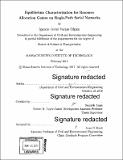Equilibrium characterization for resource allocation games on single-path serial networks
Author(s)
Vargas Olguin, Ignacio Javier
DownloadFull printable version (3.345Mb)
Other Contributors
Massachusetts Institute of Technology. Department of Civil and Environmental Engineering.
Advisor
Saurabh Amin.
Terms of use
Metadata
Show full item recordAbstract
The Resource Allocation Game we examined in this work is a strategic interaction where a principal distribute an infinitely divisible good among different agents based on their specific valuations of said good. The distribution is done by a particular scheme first studied by Kelly [15] with no price-discrimination. In a further study by Johari and Tsitsiklis [13], they aim to distribute the link capacities of a network among different users. The authors prove existence of a unique Nash equilibrium (NE) for the base case of a single link, but for a general network only existence is proven, leaving open questions about uniqueness. In this study we characterize the NE for a distinct structure of networks, the single-path serial network. The problem is tackled gradually. First, we give explicit solutions for the case with n players with affine utility functions on a single arc. Next for networks with different are capacities and all players interested in the same path within the network, uniqueness of the NE is proved. Moreover the NE is characterized by a variational inequality that correspond to the first-order conditions of an optimization problem. Thereupon, for the case where players might have different origin-destination pairs without arcs in common, uniqueness of the NE in terms of flow is again proved. Last but not least, we propose a sequential extension of the scheme. In this framework, players do not act simultaneously, but in a given order of precedence. For the base case of one arc and two players with linear utilities, we obtained an explicit Subgame Perfect Equilibrium. In addition, we get a price of anarchy better than the one obtained for the simultaneous case. We propose some thoughts about the Transportation analysis application of this type of networks for liner shipping and highways, that is to say situations where there is a single-path of interest for every player.
Description
Thesis: S.M. in Transportation, Massachusetts Institute of Technology, Department of Civil and Environmental Engineering, 2017. Cataloged from PDF version of thesis. Includes bibliographical references (pages 67-70).
Date issued
2017Department
Massachusetts Institute of Technology. Department of Civil and Environmental EngineeringPublisher
Massachusetts Institute of Technology
Keywords
Civil and Environmental Engineering.